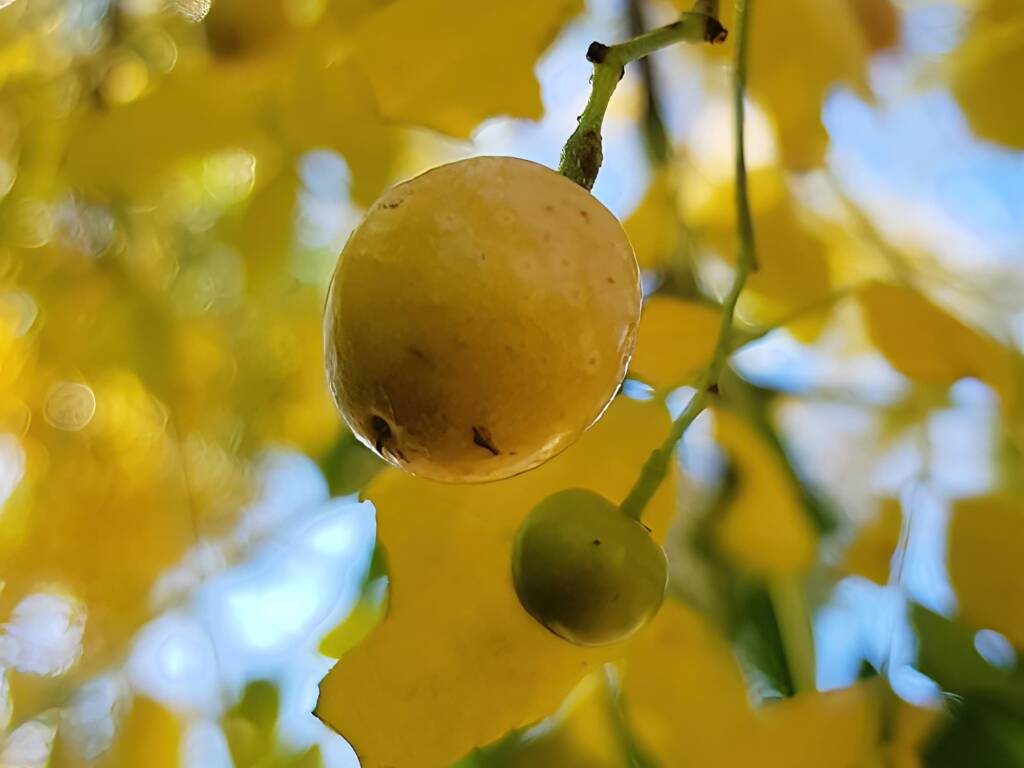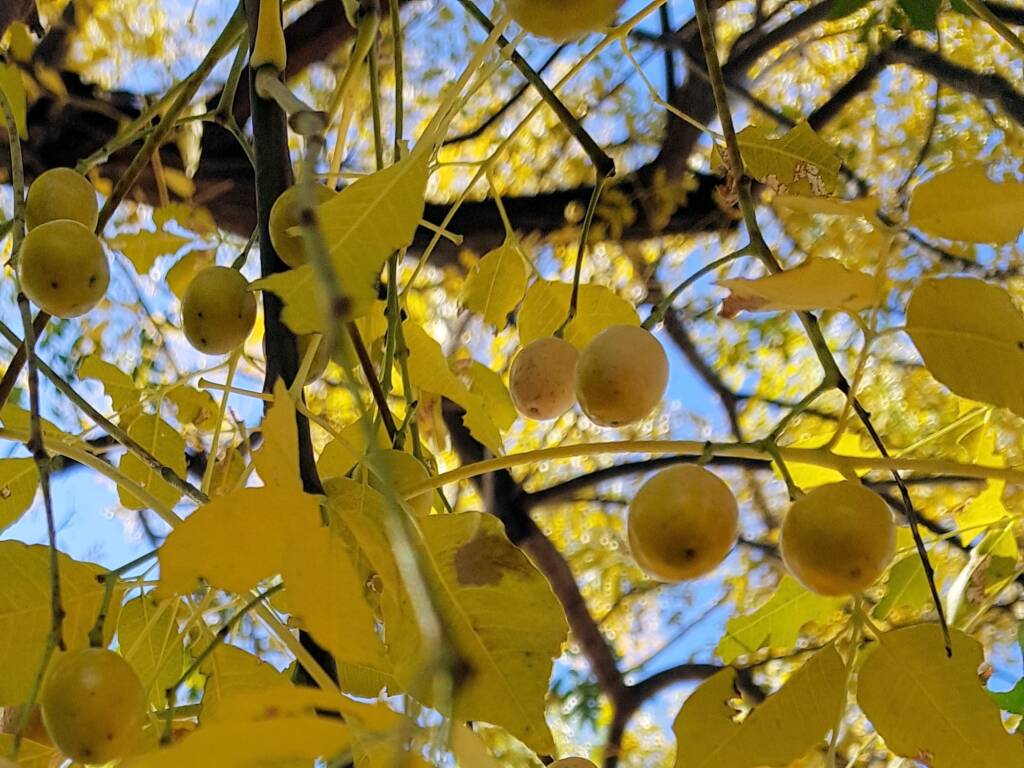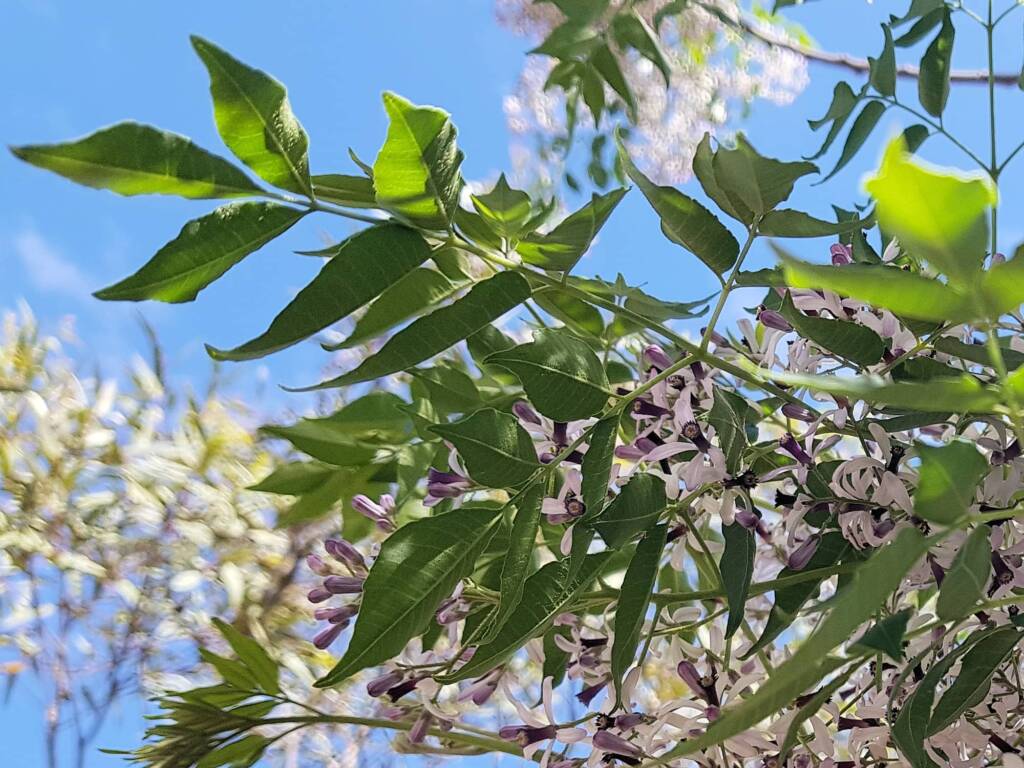A deciduous tree, the White Cedar (Melia azedarach) is native to Australia and South East Asia. It has a natural distribution from around Cooktown region in north Queensland, down through northern New South Wales and the south coast. It has been used as popular urban treescape plant and as an ornamental tree in gardens around Australia, and can be found in Victoria, South Australia, through Central Australia (Alice Springs), top end of Australia and both in the south and north parts of Western Australia.1 It is listed in the Weeds of Central Australia field guide.4

Under the right conditions, the tree can grow up to 12 metres in height, although in urban settings it may be smaller, up to 8 metres. The tree has a grey-brown furrowed bark, with leaves bipinnate to tripnnate, divided into ovate-toothed leaflets.
When in full bloom, the tree can often be seen laden with fragrant maroon-purple to lilac flowers, the flowers having five pale lilac to almost white petals.

The fruit is a drupe (or stone fruit) that has a thin skin and layer of flesh surrounding the seed (kernel). The fruit is marble size, and initially pale green, turning light yellow as the fruit matures. They can often be found still hanging on the tree, as the fruit becomes wrinkled.

The term azedarach means “poisonous tree”, with many parts of the tree being toxic, including the seed within the fruit of the tree.

Melia is from the Greek name used by Theophrastus for Fraxinus ornus, an Ash Tree (from the Gr. meli, honey, due to the sweet sap that is produced by some species). The genus Melia is named by Linnaeus, 1753, because of the opposite arrangement of the leaves resembling those of the Ash.
The name azedarach is from the French azédarac, which is in turn from the Persian Azed-darakht, meaning “noble tree”, from the Indian Neem tree (Azadirachta indica).
Due to the wide range across Australia and South East Asia, the tree has a number of common names including Bead-tree, Cape Lilac, Chinaberry, Indian Lilac, Persian Lilac, Pride of India, Syringa Berrytree, and Umbrella Cedar. In Australia, it is commonly known as White Cedar due to its soft general-purpose timber.

- Scientific classification
- Kingdom: Plantae
- Phylum: Charophyta
- Class: Equisetopsida
- Subclass: Magnoliidae
- Superorder: Rosanae
- Order: Sapindales
- Family: Meliaceae
- Genus: Melia
- Species: Melia azedarach
Footnote & References
- Melia azedarach L., Bead Tree, Atlas of Living Australia, https://bie.ala.org.au/species/https://id.biodiversity.org.au/node/apni/2894326
- Wahlenbergia capillaris, https://en.wikipedia.org/wiki/Wahlenbergia_gracilis (last visited Dec. 26, 2020)
- Melia azedarach, White Cedar, Australian National Herbarium, https://www.anbg.gov.au/gnp/interns-2008/melia-azedarach.html
- Wahlenbergia gracilis, Greening Australia, https://www.greeningaustralia.org.au/wp-content/uploads/2017/11/FACT-SHEET_Wahlenbergia_gracilis.pdf
FloraFlora in Australia Flora Index Acacia Anigozanthos (Kangaroo Paws) Annual Yellowtop Apium prostratum subsp. prostratum var filiforme Apple Bush (Pterocaulon sphacelatum) Australian Bluebell Australian Gossypium Banksia Batswing Coral Tree Billy Buttons Birdsville Indigo Blue Pincushion Bush Banana Callistemon Callitris drummondii (Drummond’s Cypress Pine) Calothamnus quadrifidus Cape Honeysuckle Cassia fistula (Golden Shower) Cattle Bush Common Heath Crotalaria Darwinia wittwerorum (Wittwer’s Mountain Bell) Daviesia oppositifolia (Rattle-pea) Desert Oaks Drumsticks Eremophila Eucalyptus Ficus Flannel Cudweed (Actinobole uliginosum) Georges Indigo Goatshead Burr (Sclerolaena bicornis) Golden Everlasting Goodenia Gossypium Grass and Grasses Grass Trees Grevillea Grey Germander Hakea Kapok Bush (Aerva javanica) Lambertia sp Leptospermum MacDonnell Ranges Cycad Maireana scleroptera Mexican Poppy Minnie Daisy Mistletoe Family Nardoo Native Apricot Nicotiana megalosiphon subspecies sessilifolia Nuytsia floribunda Orange Spade Flower Orchidaceae Parakeelyas (Calandrinia) Pebble Bush (Stylobasium spathulatum) Perennial Yellow Top Pink Everlasting Pink Rock Wort Poached Egg Daisy Portulaca Proteaceae Ptilotus Quandong Resurrection Fern Rosy Dock Ruby Saltbush Santalum Solanum Spike Centaury Spinifex Storkbill (Erodum cygnorum) Striped Mint Bush Sturt’s Desert Pea Sturt’s Desert Rose Tall Saltbush Tangled Leschenaultia Tar Vine Tribulus eichlerianus Upside-down Plant Urodon dasyphylla Variable Daisy Waratah (Telopea) Wertabona Daisy White Cedar (Melia azedarach) White Indigo White Paper Daisy Wild Passionfruit Wild Stock Woolly-Headed Burr Daisy Woolly Bush Yellow-keeled Swainsona
Flora & FaunaFauna Flora Fauna Flora Funga Glossary Funga Related Topics Scientific Classification Backyard Wildlife Floral Emblems of Australia Wildflowers
